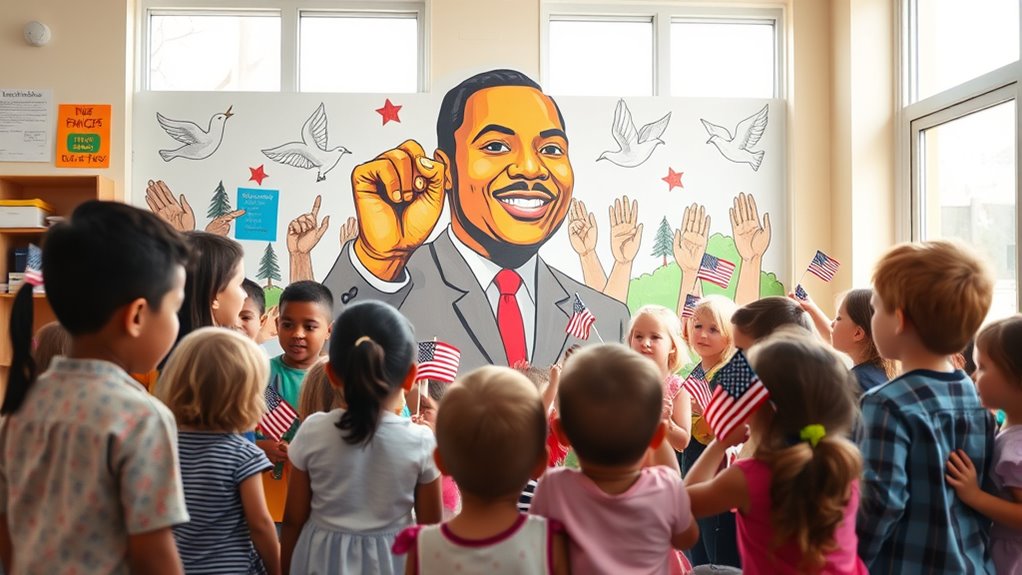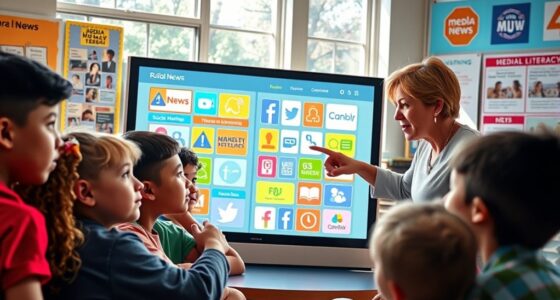Teaching kids about Martin Luther King Jr. Day helps them learn the importance of peace, equality, and nonviolence in creating a fair society. You can share stories of his leadership, highlight his “I Have a Dream” speech, and organize activities like writing letters or making posters that promote kindness and justice. Explaining these ideas shows children how standing up for others peacefully can truly make a difference. Keep exploring to discover more ways to inspire young minds!
Key Takeaways
- Explain Martin Luther King Jr.’s role in fighting for equality and ending segregation peacefully.
- Highlight the importance of nonviolence and peaceful protests in creating societal change.
- Share stories of King’s leadership to teach children about fairness, empathy, and standing up for others.
- Discuss the significance of the “I Have a Dream” speech as a symbol of hope and justice.
- Encourage activities like drawing posters or writing letters that promote kindness, fairness, and peaceful activism.

Martin Luther King Jr. changed the course of history through his powerful leadership in the Civil Rights movement. When you teach kids about him, you’re helping them understand the importance of fighting for equality and justice. King’s work was rooted in the idea that change could be achieved through peaceful means, emphasizing the principles of nonviolence. Explaining his commitment to nonviolence shows children that fighting injustice doesn’t mean resorting to violence; instead, it involves patience, understanding, and peaceful protest. You want your kids to see that King believed in the strength of words, marches, and sit-ins as effective tools to challenge unfair laws and societal norms.
Martin Luther King Jr. showed that peaceful protest and nonviolence can change history and promote justice.
By sharing stories of how King organized peaceful demonstrations, you demonstrate that nonviolence isn’t a sign of weakness but a powerful way to bring about change. For children, understanding that civil rights include the right to be treated equally regardless of skin color helps build empathy. You can explain how King’s leadership helped to end segregation and secure voting rights, all through marches, speeches, and acts of peaceful resistance. These stories teach kids that standing up for what’s right can be done without violence, inspiring them to act with kindness and courage in their own lives.
When you discuss Martin Luther King Jr., emphasize his famous “I Have a Dream” speech. This speech is a perfect example of hope and peaceful activism. It illustrates his vision of a future where everyone is judged by their character, not the color of their skin. Sharing this message encourages children to believe in a fair and just society and shows them how words can be more powerful than violence. Teaching kids about King’s dedication to civil rights and nonviolence helps instill core values like fairness, respect, and perseverance.
You can also incorporate activities that highlight peaceful protest methods, like creating posters or writing letters advocating for kindness and equality. These activities give kids a hands-on understanding of how nonviolence works. Explaining the importance of peaceful resistance through King’s example demonstrates that real change often requires patience and moral strength. Additionally, understanding the nonviolent principles that King promoted helps children see that peaceful activism can lead to meaningful societal change. By learning about his leadership, children understand that standing up for others and fighting injustice can be done with compassion and dignity. Ultimately, teaching about Martin Luther King Jr. and his commitment to civil rights and nonviolence empowers kids to become thoughtful, conscientious individuals who believe in making the world a better place through peaceful means.
Frequently Asked Questions
How Can I Make MLK Day Activities Age-Appropriate?
To make MLK Day activities age-appropriate, you can use interactive storytelling to engage young children with MLK’s message in a simple, relatable way. Incorporate art-based activities like drawing peace symbols or creating friendship bracelets to help them express key values. Keep activities short and hands-on, ensuring they’re fun and meaningful without overwhelming younger kids, fostering understanding and empathy through age-appropriate methods.
What Are Some Creative Ways to Honor Mlk’s Legacy?
You can honor MLK’s legacy through storytelling activities that highlight his messages of equality and justice. Incorporate arts and crafts by having kids create peace posters or friendship bracelets symbolizing unity. Encourage them to share stories about kindness and fairness, making the lessons personal and memorable. These creative approaches help children connect with MLK’s ideals actively, fostering a deeper understanding and inspiring them to promote these values in their daily lives.
How Do I Address Complex Topics Like Segregation With Kids?
You might worry that discussing segregation is too complex for kids, but start with age-appropriate language and relatable examples. Use simple historical context, like describing how people were treated unfairly because of skin color, to help them understand. Engage them with stories or activities that highlight fairness and kindness. This approach makes difficult topics accessible, fostering empathy and understanding while respecting their developmental level.
Are There Recommended Books for Different Age Groups?
You’ll find great reading recommendations for different age groups by exploring favorite stories that introduce Martin Luther King Jr.’s legacy. For young children, picture books like “Martin’s Big Words” are perfect. Older kids enjoy biographies like “Martin Luther King Jr.: A Life.” These books help children understand complex topics like segregation through engaging stories. Tailoring your choices guarantees your kids grasp the importance of equality and justice at their developmental level.
How Can I Involve Children in Community Service Projects?
Did you know that kids who get involved early are more likely to develop a lifelong commitment to community? To involve children in community service projects, explore volunteer opportunities suitable for their age, like neighborhood cleanups or food drives. You can also make it fun by setting goals and celebrating milestones. This boosts community engagement and teaches kids the importance of giving back, making their contributions meaningful and memorable.
Conclusion
By teaching kids about Martin Luther King Jr. Day, you’re planting the seeds of kindness and equality that can grow into a future where justice rules like an unstoppable wave. Remember, your efforts can inspire children to change the world more than anyone ever thought possible. So, keep sharing his story and values—because even the smallest actions have the power to ignite a revolution of compassion. Together, you can make history brighter for generations to come.









